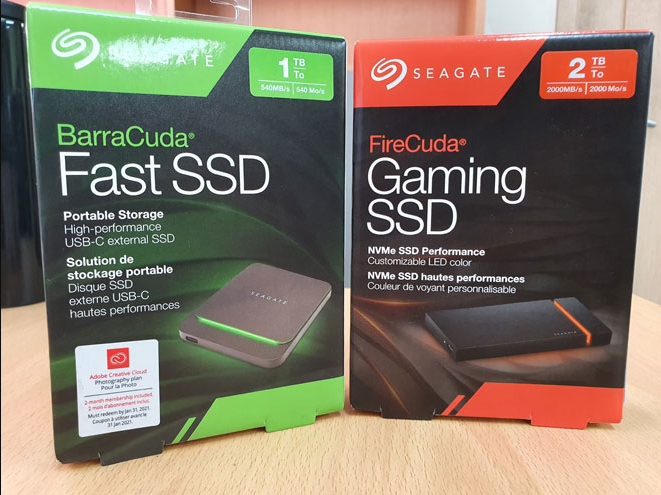
Faster external SSD to play with, Seagate Barracuda Fast SSD & Firecuda Gaming SSD
As storage technology continues to develop, there are products that are undergoing significant changes and developments at the present time as the price competitiveness of SSDs improves.
External storage, and more specifically, external SSD.
It was not an exaggeration to say that the HDD in the external storage field was tight, but SSDs can take a reasonable price in the capacitive part due to the recent NAND flash price reduction, and the best selling capacity is 1TB, 2TB level external SSDs are also competitive.
Particularly, recently, as well as SATA-based and NVMe, which is a high-speed storage-based interface of a PC, is externalized to show faster external SSDs than internal SSDs, it may be more attractive to users who need external SSDs.
Among them, Seagate, which manufactures and introduces various types of storage, recently introduced their representative storage brands, Barracuda, External Storage, which is named after FireCuda, Barracuda Fast SSD, and FireCuda Gaming SSD. I could have it.
■ Slim Barracuda, luxurious Firekuda external SSD
Looking at the Seagate Barracuda Fast SSD first, in terms of appearance, the past author reviewed it once and it looks like Seagate’s Lacie Portable SSD.
It is a product that caught the eye with its slim yet edge design, and this is also true of the Barracuda Fast SSD.
The top cover is covered with a metal cover to emphasize robustness and luxury, and the side part has a barracuda-specific green light cut.
It is not visible when not in use, but when the power is turned on, it can be seen that a green LED is attached to the front part cutting.
In particular, this design is very portable because it is slim enough to fit in a thin pocket as well as a bag.
The Barracuda Fast SSD also has a USB Type C single port configuration, but the cables provided are C to C and C To A, and USB 3.0 is supported, so you can expect a high transfer speed.
Based on the sample 1TB model, it weighs 83g, which is a light level, and can be carried lightly, so it can be compatible with various storage-supported products that support Type A and Type C USB ports even if it is not a PC.
Next up is the Firekuda Gaming SSD
In fact, as the external SSD utilizes a smaller NAND flash than the external HDD, it is characterized by being able to design small and free in structural parts depending on the arrangement.
If the Barracuda Fast SSD had a square shape, the Firekuda Gaming SSD has a slightly long rectangular shape.
Seagate’s Firecuda line was a high-performance brand and lineup specialized for gaming from generation to generation.
Recently, this external SSD and Firekuda Gaming SSD have been joined as a new Firecuda product, and it is a high-performance brand and is designed to have a feeling for high-end and gamers from the appearance to fit the product.
It can be said that the aluminum body for heat dissipation and the tactile sense (?), which is an unexpected element, were the ones that felt the biggest.
As the Firekuda Gaming SSD utilizes the NVMe interface and can speed up faster than the existing SATA-based, it is inevitable that it is an external SSD based on NVMe that needs to pay more attention in the heat generation part. I made it possible.
Also, the finish is quite good, and unlike other aluminums, I can feel a very soft touch, so I can get a very luxurious feeling from this part. In addition, you can also see the bottom surface decorated with rubber material to prevent slipping.
In addition, as the LED is provided in the Barracuda Fast SSD, the design for providing the LED is also configured in the Firekuda Gaming SSD.
In addition, the LEDs of the Firekuda Gaming SSD are RGB LEDs, and various colors and effects can be applied using the Seagate toolkit program to make the gaming environment as cool as possible.
As it is an external SSD, it is inevitable to consider the weight side, but it still provides a rather heavy feeling due to the use of aluminum metal, and 142g is specified.
Although it is a bit heavy for external SSDs, it is not regrettable enough to reduce the weight loss due to the weight in terms of portability because it is significantly lighter than the weight of smartphones these days.
■ SATA-based external SSD highest performance, NVMe-based external SSD highest performance, 2 types
Now that we have looked at the appearance, it’s time to look at what it actually does.
Since the two models of Seagate Barracuda Fast SSD & Firekuda Gaming SSD are each based on different interfaces, they are not compared to each other, so we would like to take a time to look at how well they match the specifications indicated in Seagate by running benchmark tests.
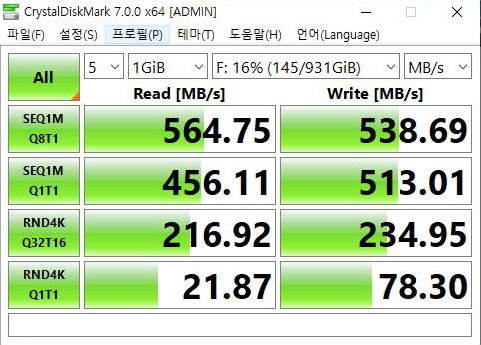
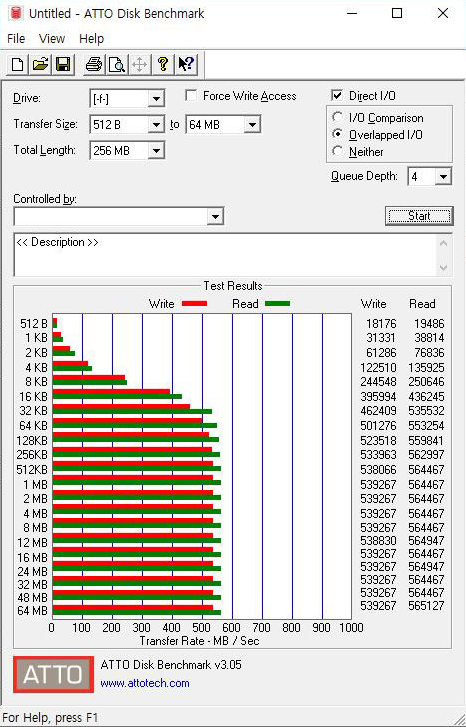
Testing utilized the universal CrystalDiskMark 7.0 and ATTO disk benchmarks.
First of all, in the case of the Barracuda Fast SSD, the highest speed was indicated at 540MB/s, which is close to the highest performance level of SATA based on the written specifications, but it showed a similar appearance in actual test results.
Both reads and writes exceeded or exceeded 540MB/s, which was actually the same or higher than the typical internal SATA-based SSD.
So, is the SATA-based external SSD still slower than the existing internal SATA SSD? It seems to me that this is a thought for Barracuda Fast SSD.
What is the performance of NVMe based FireCuda Gaming SSD?
The display performance of the Firekuda Gaming SSD 2TB model provided as a sample is 2000MB/s for read/write.
To add one explanation before the test, in fact, this powerful notation of Firekuda is not easy to perform all under normal circumstances.
The reason is that the maximum speed limit supported by USB is the maximum supported speed of the USB 3.2 Gen2 environment, which is said to have been widely distributed recently. That said, no matter how fast an external SSD is, if your motherboard or device doesn’t support it, you won’t be able to achieve speeds exceeding 1000MB/s.
It is obvious that it is a pity, but the good point is that the USB transfer speed limit will continue to increase in the future and will continue to develop further.
As an example, as well as USB 4 in the future, currently, PC-based high-end models are equipped with a Type C port that supports up to 20 Gbps named USB 3.2 Gen2X2. Obviously, it was less popular than the 3.2 Gen2 environment, but by utilizing this port, you can take full advantage of the original performance of this FireCuda Gaming SSD.
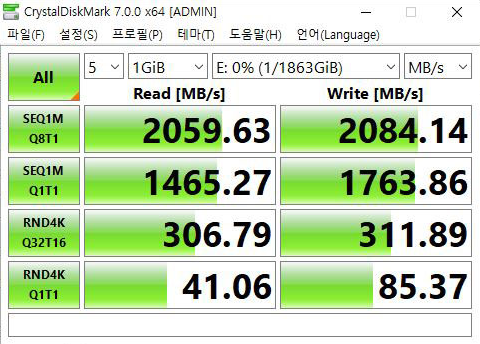
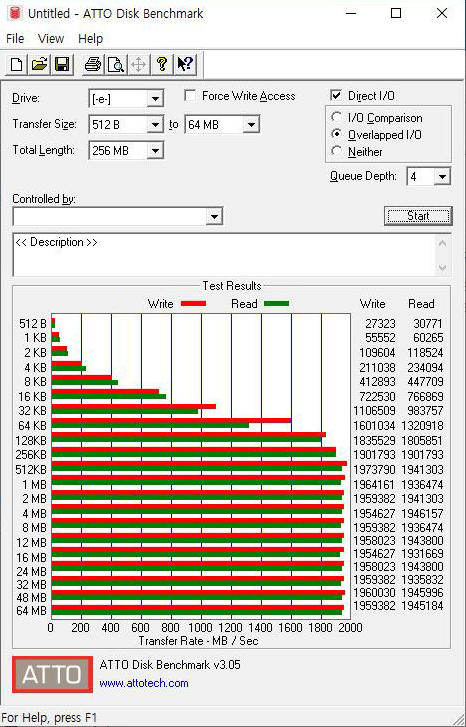
K-Bench was able to check whether the Firekuda Gaming SSD can operate according to the notation specifications using the latest Asrock Z490 Taichi motherboard supporting USB 3.2 Gen2X2 port.
As expected, we were able to confirm that the notation specification, 2000MB/s, was achieved on the benchmark.
In this part, I was quite impressed with the new part, but a while ago, the external SSD was unfamiliar, and I just wanted to get it out of the way, but it lightly picked up the performance of the built-in M.2 NVMe SSD beyond the internal SATA This is because it can be used through external USB products.
In this regard, if you have a Barracuda Fast SSD that showed the highest SSD level in SATA-based or a Firekuda Gaming SSD with a specification that lightly surpasses the built-in NVMe, the point where you do not have to stick to the built-in SSD storage is in front of us. The fact that I was approaching it is clear.
■ Check the actual use environment and heat
Through the benchmark program, it was confirmed that the product can operate up to the maximum value according to the notation specifications.
This test is a part that can be felt in a real-world environment. It is a test that allows you to immediately feel what the operating speed is and how long it takes in the OS environment.
I copied the dummy files with a capacity of about 100GB to the SSD and then copied them to another folder to check the actual tangible performance of the Barracuda Fast SSD and the Firekuda Gaming SSD. First, the copy speed of the Barracuda Fast SSD averaged 240~250MB It was kept close to /s and copied, and the approximate copying time took about 7 minutes.
The Firekuda Gaming SSD is definitely faster than this, and maintains a speed of 700 to 710MB/s, and the actual copying time is about 2 minutes, so you can experience the copy and experience as fast as the speed.
Both the Barracuda Fast SSD and Firekuda Gaming SSD boast exceptional speeds.
However, if the speed is high, heat generation is inevitably increased. SATA SSDs don’t really have a problem, but in the case of NVMe interface, it is true that the built-in models have a lot of trouble due to the heat problem.
If it’s just hot, it won’t be a problem, but if the heat gets worse, the SSD can’t perform. In particular, external SSDs utilizing the NVMe interface should be considered a more special cooling design, and should be a product prepared for this.
So, this time, using the dirty test, I checked whether the product had problems and how much temperature it would show, with the product utilization increased to 100%.
I also checked the Barracuda Fast SSD, but both products did not check for a decrease in performance due to heat, and I could clearly see that the Firekuda Gaming SSD measured the maximum temperature as high as the fast performance.
As a result, this FireCuda Gaming SSD couldn’t tear the inside out, but fortunately it was well prepared with the luxurious aluminum cover design mentioned earlier.
■ Game loading test
Except for the photorealistic test, what can these Seagate 2 types show when used in a game environment? Is there a difference in speed?
Since SSDs have not yet been able to affect game frames, we have compared SSD performance in games with loading tests.
The test compared the Shadow of the Tomb Raider benchmark loading to the internal HDD 1TB model.
As the graph shows, the results were quite effective and showed a difference. At this level, it is unlikely that there will be much difference from the internal SSD.
Therefore, if it shows this performance, it seems to be enough to select and utilize the Barracuda Fast SSD or the Firekuda Gaming SSD over the built-in model when purchasing additional storage. It seems to be enjoyable without the need for installation.
■ Seagate strengthens gaming portfolio
Personally, the part I felt while conducting a gaming test with these two products may have been a glimpse of Seagate’s recent interest in gaming external storage and the market’s attempt to lead the market. In fact, I wonder if the part of the product is the Firekuda Gaming SSD we looked at today.
In fact, Seagate has recently enhanced its gaming portfolio, in addition to today’s two products, it also introduced the FireCuda 120 SATA SSD, and also introduced the FireCuda Gaming Dock, a 4TB HDD storage hub with NVMe M.2 expansion slot. I prayed.
In addition, there are some areas where recently released next-generation consoles are expected to actively support external SSD products, and Seagate’s XBOX series X dedicated storage expansion card, which has already become a hot topic, is in the midst of Seagate strengthening its gaming portfolio. It seems to be one.
In fact, if you think about it based on the performance of the products that you have seen and published yourself, I think that if you can consistently show products of this level of performance, a bright future will shine in the storage environment in the gaming field.
■ Satisfactory performance and external SSD that shows the future of external storage
In this article, we looked at two types of Seagate Barracuda Fast SSD and Firekuda Gaming SSD external SSD.
When I looked at this product, what I felt was that it provided a very satisfactory look and performance for the external SSD itself as well as the external part.
Now, even users who need an external SSD seem to have expanded their storage options with competitive price and excellent performance.
Of course, there are a lot of things to go ahead because of the parts mentioned in the previous test, the parts that do not fully implement the performance of the embedded products to which the ports are directly connected, and the parts to be distributed.
Nonetheless, the Seagate Barracuda Fast SSD and Firecuda Gaming SSD products that we looked at at this time seem to be the most capable and capable of delivering the most satisfactory performance on each interface.
Therefore, if you are a user who needs an excellent external SSD, I think the Seagate Barracuda Fast SSD and Firekuda Gaming SSD external SSD are the best choices at this time.
